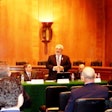“Am I my brother’s keeper?”
Genesis 4:9
For what seemed like the fiftieth time that afternoon, I interrupted my report writing to answer the phone again. I was the Operation Safe Streets (OSS) gang sergeant supervising the East Los Angeles team. My once four-man detective team was down by bureaucratic attrition to one detective and myself. Both of us were buried under a heavy gang case load.
The phone call came from the front complaint desk. One of the station dispatchers was requesting that I respond to the desk. When I arrived I saw two burly deputies talking to a wiry looking 30-year-old gang member. He had staggered into the station mumbling about someone trying to kill him. The two burly deputies ignored what he was saying, focusing instead on his thick slurred speech. He was under the influence of an opiate, maybe heroin.
The two burly deputies wanted to book him, but I was interested in hearing his story. Hype gang members do not normally seek out the police or walk into a police station. Just for my safety I patted him down for weapons and had him remove his shirt. I saw that he was heavily tattooed with prison and gang tats. His arms proclaimed that he was “Spider” from the infamous “White Fence” gang.
Besides the gang information a trained observer could also read a long history of intravenous drug use. Among the old scar tissue were fresh puncture wounds. Three of the wounds were covered in fresh blood. Spider could barely speak and although he was agitated, he had trouble remaining awake. I continued to talk with him and gave him a couple of cups of 30-weight detective coffee.
Spider’s story unraveled slowly over the next six hours. He had been an informant for LAPD but, after a recent murder in the Sheriff’s jurisdiction, he had been introduced to an LASD Homicide detective. Spider gave Homicide the names of the two murder suspects involved in the murder from talk he had heard on the street. The murder had been an especially gruesome one with the murder weapon being a shotgun used at close range. But Homicide needed more than just street talk to make an arrest.
Homicide sent Spider out to get more evidence. Shortly after the conversation with the Homicide detectives, Spider learned that a fellow gang member was trying to get rid of a “hot” shotgun. This was the shotgun used in the murder. The seller wanted $50 but Spider was broke.
However, Spider was resourceful. He visited his local heroin dealer and told him that, for $50 cash, he could buy a gram of very potent heroin from a Mexican National (Paisa) dealer, and, for a taste, he would help the dealer “step on it” three times. They could then sell the three grams and pocket the profit. This was a fable but a believable fable. The greedy dealer lent Spider the money, promising to kill Spider if he failed to return with the super heroin.
Spider reasoned that after buying the “hot” shotgun and delivering it to Homicide, he would be rewarded with enough cash to pay back the dealer’s loan. He found the shotgun seller and bought the murder weapon. When he called the detective he could not reach him. Spider spent several hours walking around East Los Angeles trying to appear inconspicuous carrying a shot gun. Then the detective finally answered his calls.
The detective told spider that he no longer needed the shotgun evidence. He had both his suspects in custody after obtaining their confessions to the murder. This was very bad news for Spider. The drug dealer was waiting for his return with the mythical super heroin. He was an ex-con in possession of a murder weapon, and he was in serious need of a heroin fix.
To make matters worse, while walking home, he was spotted by an LAPD patrol car. He was arrested and the shotgun was seized. A few days later, he was released on his own recognizance pending the trial, but this was the least of his worries.
A few blocks from the county jail spider was jumped, beaten and stuffed into the back seat of a car by two gang musclemen who worked for the drug dealer. “Where’s my dope? Where’s my money?” screamed the heroin dealer.
Spider was taken to an apartment over a business just down the street from El Tepeyac, an L.A. Mexican restaurant landmark made famous in Joseph Wambaugh’s police novels. He was placed in a small upstairs apartment over the store front, he was tied to a chair and the drug dealer injected him with enough tar heroin to kill a horse. He was left to slowly sink into the land of Morpheus, the God of sleep, never to return to the land of the living.
Spider said he did black out, but found himself awake a few hours later. Over a lifetime of heroin abuse he had built up such a tolerance that it saved his life. Fear and adrenalin strengthened him; he escaped from his lethal injection seat, he jumped out of the second story window and began running for his life.
Spider found his way to the East Los Angeles Sheriff’s Station and walked in. Although Spider believed he was moving fast, after several hours he was still talking and moving in slow motion. Other cops were betting that Spider was making all this up as an excuse for his opiate intoxication. However he had marks on his wrists and abrasions on his hands and knees from a fall. I called LAPD Hollenbeck Station and confirmed that he had been arrested with a shotgun a few days earlier.
There was one sure way of checking out his crazy story. I placed a call to Homicide. The detective confirmed that Spider had been working for him, but said he did not need him anymore because he had the murderer’s confessions. I told the detective how Spider had borrowed the $50 to buy the murder weapon and how he was arrested and the shotgun confiscated. I told him about how the drug dealer had attempted to kill Spider with a “hot shot.”
It was obvious to me that the detective would not be coming to Spider’s aid, not in court, and not with the drug dealer. He said he could pick up the murder weapon at a later date from LAPD, but Spider was on his own. As I held the telephone to my ear I was speechless. I guess the detective thought the conversation was over because he hung up the phone.
I tried to make excuses to Spider, but I was embarrassed by my colleague’s lack of human compassion. In the world of gangs and drugs, Spider had burned his own connection and betrayed his gang, only to be rewarded by being thrown to the wolves by the cops.
After he had spent many hours of drinking black coffee and sobering up, I asked Spider if anyone in his family was not a gangster and possibly lived outside the area. He said that he had a sister who lived in Pomona about 20 miles away. I asked him if he could stay with his sister for a few days. He said sure but he needed to get a few things at his mother’s house in White Fence territory.
Spider called his sister on my phone and asked her to pick him up at his mother’s in about an hour and a half. I drove him to his mom’s place in an undercover car, gave him $75, and told him not to talk to his homeboys or leave the house for any reason until his sister got there. I returned to East Los Angeles, signed out, and went home about 10 that night.
I was awakened by the telephone ringing at about four in the morning. It was LAPD Hollenbeck Homicide calling. They had an unidentified murder victim or “John Doe” killed in the early hours of the morning. The victim had my business card in his pocket. They asked if I could come down first thing in the morning to identify the murder victim at the county morgue.
If you watch CSI or some other police forensics television program you probably have an idea that the morgue is this sterile, neat, white room with pull out refrigerated drawers hiding the horror of our urban murder rates. But in L.A. the rooms are huge and the bodies are stacked on stainless steel racks, four on each side reaching the ceiling. There were about five or six of these in the room they led me into. Naked human bodies, toe tagged, and some partially wrapped in sheets of clear plastic, filled the racks.
Looking over his clipboard the busy coroner’s assistant was trying to find John Doe number 26, but I saw him first. Spider’s arm hung down from the third tier of the rack. I quickly recognized his White Fence gang tattoos, and there could be no mistake as I looked at his now somehow smaller wiry face and frame.
Several large open stab wounds were scattered on Spider’s body, with one that reminded me of the one on Jesus’ side. He had dared to return to White Fence turf, probably to score some dope. The drug dealer’s minions had caught up with Spider or the gang had found out he was a police informant. Either way, it cost him his life.
Why should we care about the death of Spider? He was a drug addict and gang member with few socially redeeming attributes. However he was a human being. There is a famous homicide detectives code that states that every victim’s life has value and that we become the voice and advocate for every voiceless murder victim, even the most humble. Spider tried to do just that, and he paid the ultimate price.

















